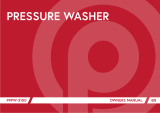
POWXG9009 EN
Copyright © 2021 VARO NV P a g e | 12 www.varo.com
15 STORAGE
If the engine is not to be used or is to be stored for more than one month the following storage
procedure should be carried out. Drain all the fuel from the fuel tank (picture 1, part 11) and
the carburettor ensure that all the fuel has been removed.
Remove the spark plug
Pour approximately one tablespoon full of clean engine oil into the spark plug hole.
With the ignition turned OFF gently pull on the recoil starter cord (picture 1, part 16)
several times. Re-fit the spark plug continue to pull the recoil starter cord until the piston is
on the compression stroke (when resistance is felt) then stop pulling.
Store the pressure washer in a dry well ventilated place under a cover to prevent any dust or
debris from accumulating on the pressure washer.
16 PREPARATION FOR WINTER AND LONG TERM STORAGE
If the pressure washer is not to be used for more than 3 months or if there is a danger of ice or
frost during winter months the pump unit will require protection to prevent seizing and damage
caused by freezing. To protect the pump unit, mix a solution of automotive antifreeze as
recommended on the antifreeze packaging. Carefully pour the solution into the pressure
washer pump inlet. When the solution drains out of the outlet, seal the outlet with a cork or
other suitable bung. Continue to pour the antifreeze solution into the inlet until the pump is full
then seal the inlet with a cork or other suitable bung.
When the pressure washer is to be used for the first time following the antifreeze protection
ensure that all the antifreeze is flushed out of the pump, hose and lance.
When the pressure washer is first started, small leaks may occur from the pump. These will
disappear after a short time.
17 WARRANTY
This product is warranted for a 36-month period effective from the date of purchase by the
first user.
This warranty covers all material or production flaws excluding : batteries, chargers,
defective parts subject to normal wear & tear such as bearings, brushes, cables, and
plugs, or accessories such as drills, drill bits, saw blades, etc. ; damage or defects
resulting from maltreatment, accidents or alterations; nor the cost of transportation.
Damage and/or defects resulting from inappropriate use also do not fall under the
warranty provisions.
We also disclaim all liability for any bodily injury resulting from inappropriate use of the
tool.
Repairs may only be carried out by an authorised customer service centre for Powerplus
tools.
You can always obtain more information at the number 00 32 3 292 92 90.
Any transportation costs shall always be borne by the customer, unless agreed otherwise
in writing.
At the same time, no claim can be made on the warranty if the damage of the device is the
result of negligent maintenance or overload.
Definitely excluded from the warranty is damage resulting from fluid permeation, excessive
dust penetration, intentional damage (on purpose or by gross carelessness), inappropriate
usage (use for purposes for which the device is not suitable), incompetent usage (e.g. not
following the instructions given in the manual), inexpert assembly, lightning strike,
erroneus net voltage. This list is not exhaustive.
Acceptance of claims under warranty can never lead to the prolongation of the warranty
period nor commencement of a new warranty period in case of a device replacement.
Devices or parts which are replaced under the warranty therefore remain the property of
Varo NV.
We reserve the right to reject a claim whenever the purchase cannot be verified or when it
is clear that the product has not been properly maintained. (Clean ventilation slots, carbon
brushes serviced regularly, etc.).















